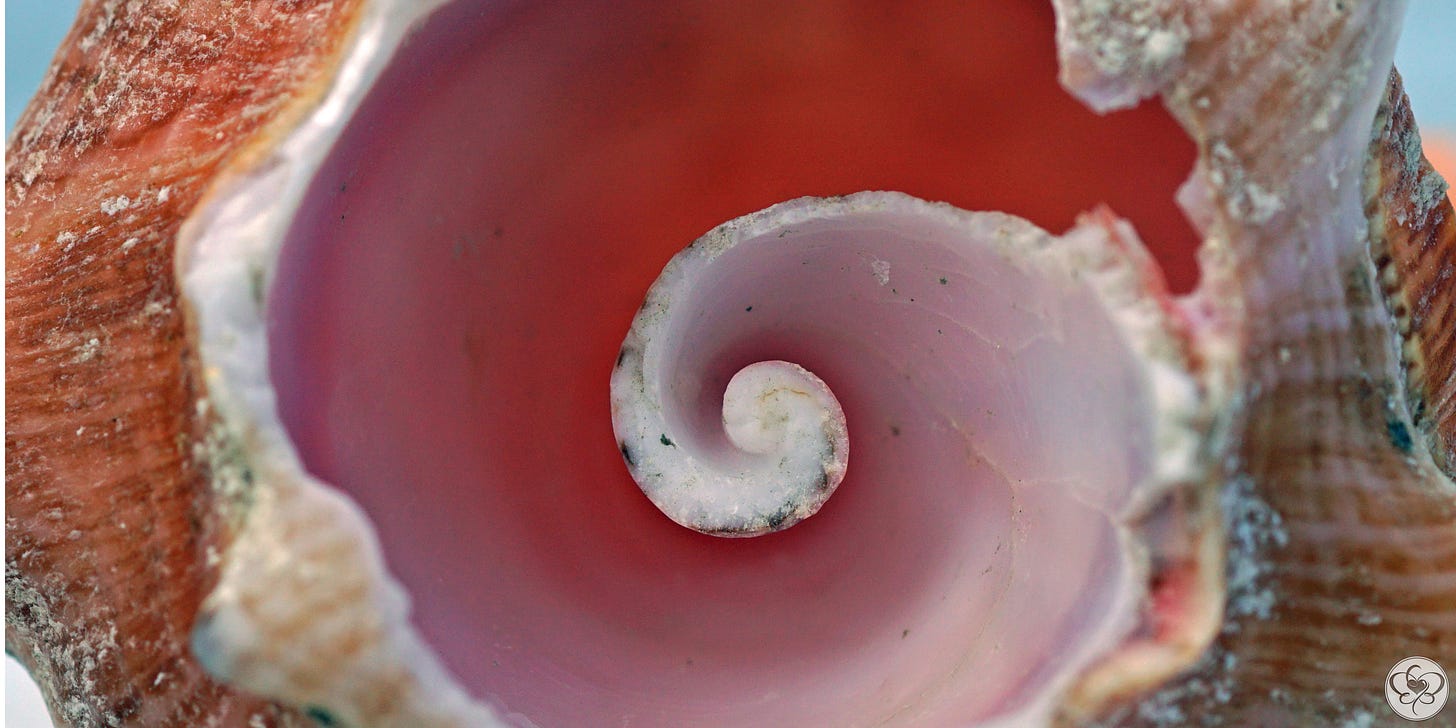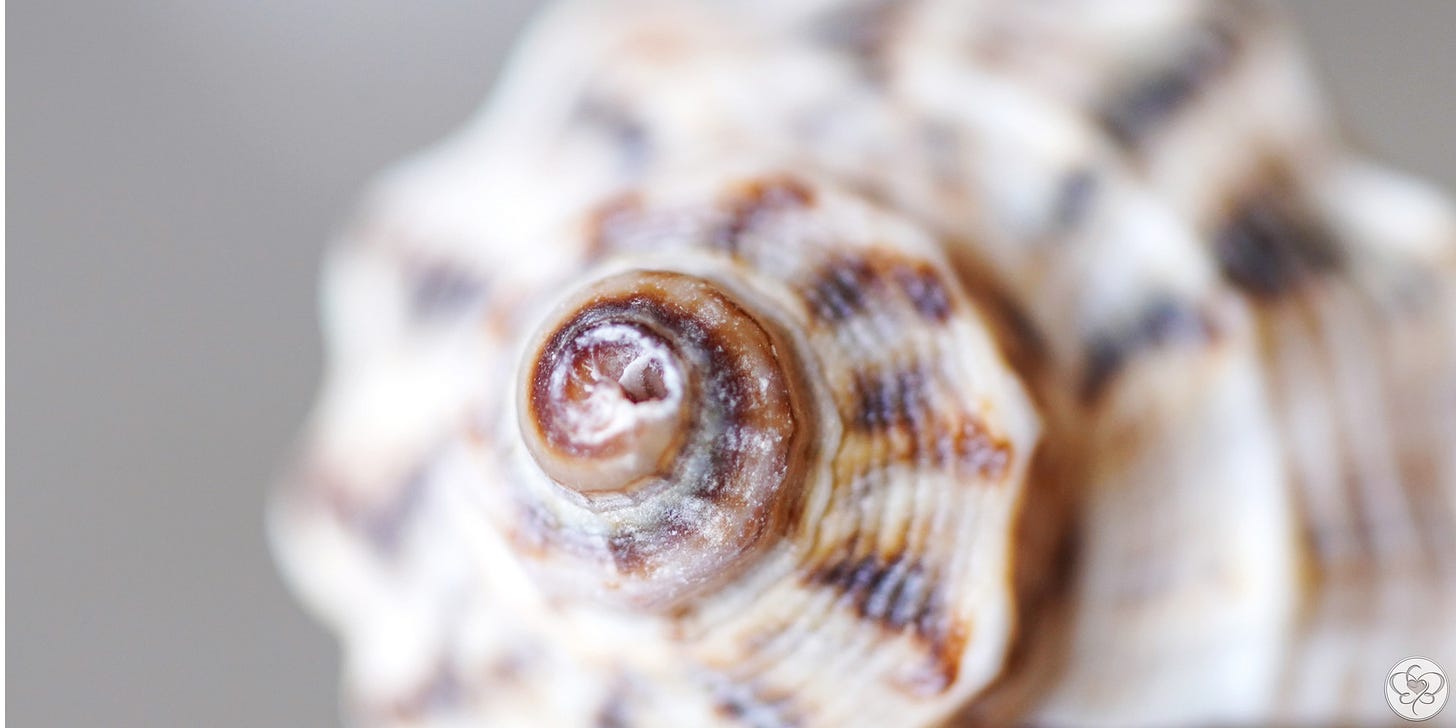The Ocean's Echo: Shells and the Symphony Within
Why pressing a shell to your ear reveals the rhythms of your own body
As children, we learn that conch shells hold the ocean's rhythms and sounds. That placing one against our ear lets us hear the distant crash of waves, even hundreds of miles from shore. It's a magical notion, one that speaks to our deep connection with the sea. But the truth behind this phenomenon is far more intimate and extraordinary than any fairy tale.
Did you know that the sound you hear isn't the ocean at all. It's you.
The Architecture of Amplification
A conch shell is nature's acoustic chamber, its spiraling interior designed by millions of years of evolution to protect the mollusk within. When we hold this shape to our ear, we create a collaboration between biology and physics: transforming the shell into a resonator that amplifies the subtle sounds already present in our bodies.
Every moment of your life, your body generates a quiet symphony. Your heart pumps blood through vessels near your ear. Your breath moves through your respiratory system. Most remarkably, cerebrospinal fluid (the clear liquid that bathes your brain and spinal cord) pulses, creating pressure waves that ripple through the craniosacral system.
These sounds are normally too faint for conscious perception, drowned out by the ambient noise of daily life. But the conch shell changes everything.
The Craniosacral Symphony
The craniosacral system represents one of the body's most elegant rhythms. Cerebrospinal fluid surges through the ventricles of the brain and around the spinal cord, creating a hydraulic pulse that subtly expands and contracts the skull. This rhythm, typically 6 to 12 cycles per minute, operates independently of breathing and heartbeat, like a deeper tide within the body's ocean.
This rhythm represents your body's deepest tide, a fundamental pulse that reflects the health of your central nervous system.
The Physics of Inner Sound
When you press a conch shell to your ear, you're creating a resonant chamber that captures and amplifies these internal rhythms. The shell's curved interior, gather the faint sounds of blood flow, the whisper of cerebrospinal fluid movement, and the distant percussion of your heartbeat. The result is that familiar whooshing sound: rhythmic, oceanic, alive.
The acoustic properties that make this possible are surprisingly simple. Any hollow chamber will amplify certain frequencies while dampening others, based on its size and shape. The conch shell's spiral form creates multiple resonant frequencies, producing a complex wash of sound rather than a single pure tone.
Your ear canal, too, contributes to this effect. The small space between the shell and your eardrum becomes part of the resonant system, creating feedback loops that emphasize the rhythmic patterns of your internal circulation.
The Deception of Memory
Why do we perceive these internal rhythms as ocean sounds? The answer lies in pattern recognition and the profound imprint that water sounds have on human consciousness. The rhythmic whoosh of cerebrospinal fluid and blood flow shares the same temporal signature as waves washing against shore: irregular but predictable, with a fundamental frequency that speaks to something ancient in our neural architecture.
From our time in the womb, surrounded by amniotic fluid and the rhythmic pulse of our mother's circulation, to our evolutionary heritage as creatures of the tidal zones, we are hardwired to find comfort and meaning in these liquid rhythms.
The conch shell simply reveals what was always there: the ocean within us.
A Living Meditation
Understanding the true source of the shell's sound doesn't diminish its magic. Actually, it deepens it.
When you hold a conch to your ear, you're not listening to a recording of distant waves. You're hearing the real-time rhythm of your own life force, the hydraulic pulse that keeps your brain nourished and your consciousness afloat.
This internal ocean never sleeps. Even now, as you read these words, cerebrospinal fluid is flowing through the chambers of your brain, carrying nutrients and clearing waste, maintaining the delicate pressure that allows your neurons to fire in the patterns we call thought. Your heart is pushing blood through the tiny vessels near your inner ear, creating microscopic pressure waves that ripple through bone and tissue.
The conch shell is simply the instrument that lets you hear what mystics and meditators have long known: we carry the rhythms of the cosmos within us. The same forces that drive the tides, gravity, pressure, the dance between containment and flow, operate within the cathedral of our skull.
The Echo of Understanding
Next time you encounter a conch shell, resist the urge to dismiss it as a tourist curiosity.
In that spiraling chamber, you'll find something more precious than any ocean recording: the sound of being alive. The shell doesn't capture the ocean's voice, it reveals that you've been carrying it with you all along.
The ocean calls to us not because it is distant, but because it is home
Interested in learning more about sound? My dear friend and colleague Shannon Hawley taught me the ins and outs of sound healing, instruments and the art of sound healing. You can learn more about her through her Substack and her website Song and Sound Healing.
.



